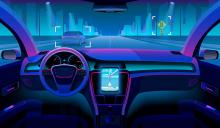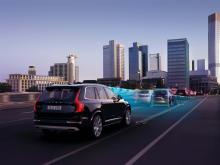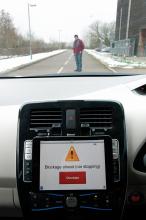
Driverless cars will have a detrimental effect on congestion and security while the road safety benefits can be achieved sooner and cheaper using ADAS, argues Colin Sowman.
Many Governments are consulting about the introduction of driverless vehicles and even running trials. As 70% or 80% of crashes are caused by human error, the promise of a crash-free future of driverless, self-driving or autonomous vehicles (call them what you will) is alluring, as are the claims of reduced congestion and lower emissions.
However, these claims do not stand up to scrutiny and most of the safety benefits could be realised sooner and more cheaply through advanced driver assistance systems (ADAS). Indeed the complexity of realising driverless vehicles and ensuring in-service reliability means that task will be difficult, ongoing and costly. Far more worrying is that the unintended consequences allowing driverless vehicles for the masses will be overwhelmingly detrimental.
Practicality
While humans can cope with broken or temporary traffic lights, pot holes and missing drain covers, flooded roads, poor road markings, obscured speed signs and much more, automated systems will struggle. Driverless vehicles will need very high definition and constantly updated digital maps and a very possibly a higher consistency of markings and signage than is currently reality on most roads. And as most road fatalities occur outside built-up areas, reducing those casualties would require such standards to be met on all rural roads. The upgrading and ongoing infrastructure and mapping costs may well be beyond the reach of public funding and would take years to accomplish.
Any obscured sign or ‘inadequate’ demarcation could raise liability issues in the event of a collision.
Marking, mapping, signage and signals are most likely to be of a useable standard on the highways and motorways (generally the safest roads) and in built-up areas.
Without a 100% guarantee of operating anytime and anywhere (such as a dedicated shuttle), driverless vehicles will need to retain a manual control option to cope with unexpected situations. High-risk and thrill-seeking drivers will use this option to continue to speed, tailgate, change lanes aggressively and so on thereby nullifying some safety gains. Furthermore, having manual drivers repeatedly pull out front of or otherwise ‘carve up’ driverless vehicle (which would brake to avoid a collision) would create discomfort and frustration for those onboard.
Equally, drivers relying on self-driving systems will lose practice in controlling the vehicle and become more likely to make mistakes when required to retake control in situations the automation cannot handle.
It would therefore be far more effective, cheaper and socially desirable to utilise such crash avoidance technology as ADAS and prevent human drivers from making the mistakes that cause crashes. According to the UK’s
ADAS systems can already detect people, cyclists or other objects in the vehicle’s path and unlike human drivers, these systems can cover all approach angles all of the time and can apply the brakes in a few milliseconds. If widely deployed, or even mandated, this technology could have a significant impact in reducing the rising numbers of pedestrians and cyclists killed and injured every year.
Adaptive cruise control is already helping prevent tail-end shunts and weather (mainly visibility) related crashes. The computer not only brakes faster, it utilise detection methods beyond the capability of the human eye. Smart systems that prevent vehicles from exceeding the posted limit are being trialled in London’s buses to relieve the driver of that task and allow them to concentrate on the road ahead.
Warnings about poor driving conditions, roadworks ahead and tailback alerts, sharp bend ahead can be sent to drivers using connected vehicle technology as can congestion reducing information such as live traffic updates, ‘speed to green’ and parking availability.
These technologies are the reserve of driverless vehicles and so should not form part of the consideration about the desirability or otherwise of driverless vehicles. If such systems were mandatory on new vehicles they would prevent many of that 70% to 80% of crashes caused by human error, in a shorter timespan than full driverless operation and at minimal or no cost to the road authorities or government.
With crash mitigation nullified, the question arises about who benefits from driverless vehicles - the answer depends on the type of vehicle and who owns it. Self-driving buses and shuttles (currently being trialled) could lower the cost of public transport and allow an increase in frequency which would benefit society as a whole. Platooning driverless trucks could operate in controlled environments to reduce the costs and environmental impact of freight transport – again widely beneficial – and potentially release capacity on overcrowded railways.
In sharp contrast, the unique benefits of driverless cars apply only to the person(s) inside the vehicle. If driverless cars are permitted for sale to the mass market, the effect would be excessively detrimental to other road users and society at large.
Increased congestion
Advocates say driverless vehicles will reduce congestion because they need less headway on the highways or motorways and can use narrower lanes because they do not deviate. Technically correct but as long as traditional vehicles remain this can only be realised with dedicated (albeit narrow) ‘driverless only’ lanes or roads which for decades would be socially divisive.For commuters a self-driving car is akin to having a chauffeur and freed from driving they can work or socialise while commuting. This, coupled with removing any concern or cost of parking, will encourage more people to commute by car and actually increase congestion. Longer travel time will not concern those working or socialising in driverless vehicles but will greatly inconvenience other road users and have a detrimental effect on air quality.
Ex-
Worst still, either by default or instruction, the driverless vehicle could endlessly circle round local roads while the owner has a meeting or a meal. Again this would not concern the vehicle’s owner but would be very detrimental to local residents, workers and other road users.
Level 5 driverless cars (see figure 3) would be used to deliver ‘forgotten items’ to school children and departed visitors. They would also replace fleets of motorcycle and bicycle couriers who deliver packages around large cities and take-away meals nationwide – increasing CO2 emissions and congestion as well as adversely impacting employment.Indeed a recent white paper published in America by consultancy
Also relevant are the figures obtained by the UK’s Institute of Advanced Motorists which show that despite the potentially fatal consequences, almost half of pedestrians knocked down by a vehicle did not take enough care before stepping into the road.
If pedestrians and cyclists know vehicles (ADAS or driverless) will not hit them, they will walk or cycle across roads at will which could bring city-centre traffic to a near standstill. While the increased safety is to be welcomed, additional measures or legislation will be needed to control pedestrians cyclists in order to keep the traffic flowing.
Car sharing and ride sharing:
Driverless cars could boost car sharing (whereby agencies - or car clubs - own the vehicles which members drive for short periods and leave them in reserved parking places for other members to use). Figures suggest that in cities like London, each car club vehicle displaces between 10 and 20 privately-owned vehicles.
However, authorities can already encourage car sharing by allocating additional dedicated parking to increase convenience.
Advocates also point to driverless cars increasing ride or taxi sharing whereby one vehicle may pick up two or more people going in the same direction. While this is already available, the evidence shows that up to 80% of car journeys are made with a single occupant.
In addition, without a third person like the taxi driver, many people will be reluctant to share a small, enclosed and private space with strangers as is evident in America where under-used high-occupancy lanes are being converted to high-occupancy toll lanes. These allow driver-only vehicles to use the lane for a fee although it is commonly acknowledged that congestion problems cannot be solved with single-occupancy vehicles.
The Dutch Spitscoren project showed that journey matching websites and mobile phone apps, where the individuals become known to each other before a journey, have a positive influence on encouraging ride sharing. It seems unlikely that driverless vehicles would have any influence on such arrangements.
A driverless car could act as a taxi, summoned by a ride-hailing app similar to Uber. This could lower prices (albeit at the expense of jobs) but as ‘black cabs’, minicabs, Uber and others already operate in many major cities, there would be no benefit for travellers or on congestion and air quality. Conversely, there is potential to increase congestion and pollution if driverless taxi firms flood cities with vehicles to ‘land grab’ the area.
Air quality:
Driverless vehicles would be more fuel efficient than their human-driven equivalent although these gains are insignificant in comparison with the CO2 emissions and air quality benefits of electric vehicles. Again in any reasoned consideration, the benefits of driveline advances must be set aside from those of driverless operation.
Elderly and disabled users:
Driverless vehicle could increase safety and mobility for older drivers and those with visual impairment or physical disabilities but other developing transport trends, such as Mobility as a Service (MaaS) will be able to provide better individual solutions without necessitating driverless vehicles. Indeed the driver could provide guidance and assistance for the disabled or infirm passengers.
Security threat
Advocates of driverless vehicles fail to address or deliberately ignore fundamental flaws in the concept. The most obvious is cyber security where repeated high-profile ‘hacks’ have showed the inability of vehicle manufacturers to prevent the misuse of their on-board systems.While progress has been made in preventing ‘mass’ hacks, currently there is no counter to individual hacks and the ongoing battle comes with no guarantees. The potential consequences of a hack on a driverless vehicle (possibly without a steering wheel) are far worse than with ADAS where the driver controlling the vehicles would be instantly aware of the situation and retain influence over the steering and brakes (and possibly the clutch). Furthermore, unlike fully autonomous vehicles, ADAS is only active for part of the time on some of the controls, so the consequences of mis-operation are less likely to be as serious.
Far more worrying from the security viewpoint is that it would be simple to misuse driverless vehicles and the consequences could be far more devastating.
By simply walking out in front of a driverless vehicle, braking sharply ahead of it or placing cones across a road, criminals could divert a driverless vehicle to hijack it, steal the cargo or rob the passengers. This is particularly the case where the ‘driver’ cannot assume control.
Examples of such behaviour have been seen in and around Calais in France where migrants have been trying to stop cross-channel trucks to allow illegal immigrants to climb aboard.
Even more frightening is the potential for terrorists to use an unoccupied Level 5 self-driving car to deliver a bomb to an intended target. This poses a far greater threat than a suicide bomber as one individual could send many bombs – perhaps simultaneously. More worryingly still, is that without the need for personal sacrifice, and with the potential to evade arrest, many more radicalised individuals may decide to act. Put in context, in France the actions of 20 or so terrorists have caused the deaths of more than 230 people while the country’s authorities are currently monitoring 15,000 radicalised individuals.
Furthermore, a group of individuals could use driverless vehicles to launch a coordinated attack on a particular location from different directions - which would be very difficult to prevent.
I have raised these concern to government employees on both sides of the Atlantic and have not received any meaningful indication that this threat can be countered. This threat also applies to delivery drones.
Autonomous vehicles can be advantageous to society in certain dedicated operations. But in terms of vehicles owned and used by the public, enhanced ADAS would provide similar safety gains in a shorter timescale and without the negative impact on congestion, air quality employment and security that would come with the deployment of driverless cars.










